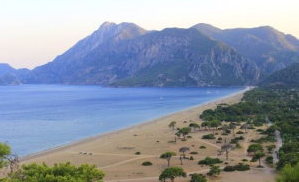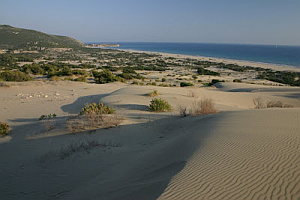accordion-category-EN
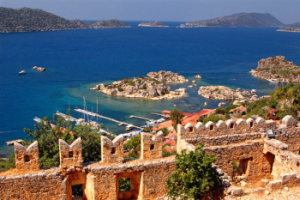
* Read More: What to know in Kekova
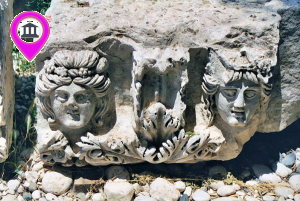
* Lycian Way all Etaps
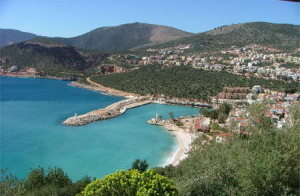
A small peaceful Mediterranean resort and fishing town on the beautiful Turquoise Coast of Turkey, Kalkan has not been touched by mass tourism. More sophisticated than the usual resort town, Kalkan appeals to travelers looking for more than a “sun and sea” holiday. According to the Sunday Times, Kalkan attracts the kind of visitor who would also enjoy Tuscany or the Dordogne. The Guardian likens the town to “the Italian Riviera minus the poseurs.”
Because of its great charm, Kalkan has a growing number of perennial visitors who say the town is the only holiday destination they would choose to visit repeatedly. There is simply no other town quite like Kalkan along Turkey’s coast.
"Mouse" and "Snake" Islands in Kalkan Bay
Kalkan curls snuggly around a historic harbour sheltered at the foot of the towering Taurus Mountains. (Read more about the geography of the region at our Lycia website here) The town overlooks a beautiful bay in which islands seem to magically float upon the shimmering sea.
Narrow streets twist down to the harbour, lined with old whitewashed villas with shuttered windows situated alongside small local specialty shops and restaurants in historic buildings. Overhead hang original carved Ottoman Greek timber balconies garlanded with thick masses of brilliantly coloured bougainvillea cascading to the streets below. It is a very special place with a unique atmosphere.
* Read More: What to know in Kalkan
* Restaurants, Cafés, Bars & Mayhanes in Kalkan/ MAP & LIST ![]()
![]()
![]()
![]()
* Hotels, Pansions, Camping Sites in Kalkan / MAP & LIST ![]()
![]()
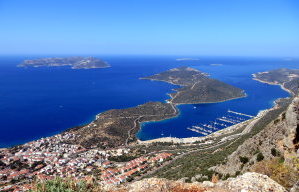
Kas is the last county town located on the south-west cost of Antalya. Antiquity name of Kas was Antiphellos (facing Phellos). As written on ancient sources; Antiphellos means “the extension of Phellos on sea” or the “coast of Phellos (stony place)”. Antiphellos is now a village located on the north of Kas and called Cukurbag.
* Read More: What to know in Kaş
* Restaurants, Cafés, Bars & Mayhanes in Kaş/ MAP & LIST ![]()
![]()
![]()
![]()
* Hotels, Pansions, Camping Sites in Kaş / MAP & LIST ![]()
![]()
There are 3 paragliding centers in Lycia: Oludeniz (near Fethiye), Kaş and Olympos.
Oludeniz is one of the best places in the world for paragliding and in the last ten years has become a mecca for paragliders from all over the world. Incredible thermals and ideal conditions make for amazing flights from Babadag Mountain down to beautiful Oludeniz beach with its long stretch of white sand and turquoise blue water.
The International Oludeniz Air Games Festival is held every year at Oludeniz beach. Lots of fun stuff to do and see.
Kaş and Olympos also offers spectacular paragliding over the mountains and sea.
Tandem paragliding isn't scary and is surprisingly relaxing.
 * Paragliding in the Lycian Sky / Map & List
* Paragliding in the Lycian Sky / Map & List

Crystal clear diving in the Mediterranean Sea ...
The crystal clear sea offers excellent diving conditions with high amount of underwater life, visibility up to 40 meters and beautiful underwater rocky landscapes. You just won’t find coral reef here. In September/October the water temperature is ideally at 27°C!
There are about 30 dive sites, reachable within 20/30 minutes from the port of Kas. The variety is quite impressive, you can go wreck-diving, cave-diving and you can swim through canyons and tunnels.
If you are lucky, you might see dolphins, a Mediterranean monk seal, octopus or maybe even a seahorse (I did! but the poor thing with a dozen of divers taking pictures of it…). The interesting fact about fauna here is that you can meet migrant species normally indigenous to the Red Sea, with encounters of loggerhead turtles, eagle rays, moray eels, groupers, and trumpet fish! It seems they have found their way from the Red Sea, through the Suez Canal and into the Mediterranean Sea! But unlike tropical areas where fish are everywhere, in Turkey you have to be in the right place at the right time.
 * Scuba diving Centers around Lycian Coast / MAP & LIST
* Scuba diving Centers around Lycian Coast / MAP & LIST
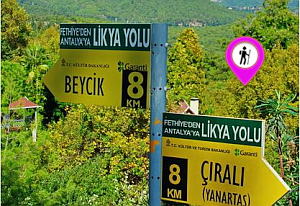
The Lycian Way is a coastal walk and mild temperatures mean it can be walked throughout the winter months.
The route is graded medium to hard; it is not level walking, but has many ascents and descents as it approaches and veers away from the sea. It is easier at the start near Fethiye and gets more difficult as it progresses. We recommend walking the route in spring or autumn; February-May or September-November; summer in Lycia is hot, although you could walk short, shady sections. The route is mainly over footpaths and mule trails; it is mostly over limestone and often hard and stony underfoot.
On the first part of the route, and in Patara, Kalkan, Kas, Myra, Finike, Adrasan, Olympos, Cirali and Tekirova, you can stay in pensions or small hotels. On other nights, you may stay in a village house, or camp out. There are plenty of camping places with nearby water mentioned in the book; you do not have to ask permission to camp out.

All pre-Greek peoples of Anatolia excelled in building monumental tombs associated with some form of ancestor worship; the Phrygians, Carians and Cilicians had their distinctive styles. The Lycians, however, developed this tradition to its artistic perfection. The landscape of Lycia is thoroughly marked by their strange, evocative and beautiful funerary monuments. Lycian tombs come in three major types. Visually the most striking are no doubt the rock tombs -more or less elaborate funeral chambers carved directly from the rock, usually into a cliff. The oldest of these are simple pigeon-hole cubicles of the sort best viewed in Pinara. More commonly, the graves are fashioned like the facade...
» Read more ..
If you really want to get a feel for southwestern Turkey’s Mediterranean coast, you have a great option: Hike the 300-mile Lycian Way, which stretches from Ölüdeniz to just shy of Antalya. Opened in 2000 as the country’s first long-distance trail, it’s been ranked one of the “World’s Ten Best Walks” by the Sunday Times. The route has many inland sections but provides plenty of awesome sea views from ridges and mountains high above the water, and also passes through plenty of ruins. It takes its name from Lycia, an ancient kingdom based in the region as far back as the 15th century BC. Budget 20-30 days to walk the entire trail, or explore shorter sections on day hikes out of towns like...
» Read more ..
There are 3 paragliding centers in Lycia: Oludeniz (near Fethiye), Kaş and Olympos.Oludeniz is one of the best places in the world for paragliding and in the last ten years has become a mecca for paragliders from all over the world. Incredible thermals and ideal conditions make for amazing flights from Babadag Mountain down to beautiful Oludeniz beach with its long stretch of white sand and turquoise blue water.The International Oludeniz Air Games Festival is held every year at Oludeniz beach. Lots of fun stuff to do and see.Kaş and Olympos also offers spectacular paragliding over the mountains and sea. Tandem paragliding isn't scary and is surprisingly relaxing. * Paragliding in the...
» Read more ..
Crystal clear diving in the Mediterranean Sea... The crystal clear sea offers excellent diving conditions with high amount of underwater life, visibility up to 40 meters and beautiful underwater rocky landscapes. You just won’t find coral reef here. In September/October the water temperature is ideally at 27°C!There are about 30 dive sites, reachable within 20/30 minutes from the port of Kas. The variety is quite impressive, you can go wreck-diving, cave-diving and you can swim through canyons and tunnels.If you are lucky, you might see dolphins, a Mediterranean monk seal, octopus or maybe even a seahorse (I did! but the poor thing with a dozen of divers taking pictures of it…). The...
» Read more ..
Kas is the last county town located on the south-west cost of Antalya. Antiquity name of Kas was Antiphellos (facing Phellos). As written on ancient sources; Antiphellos means “the extension of Phellos on sea” or the “coast of Phellos (stony place)”. Antiphellos is now a village located on the north of Kas and called Cukurbag. * Read More: What to know in Kaş * Restaurants, Cafés, Bars & Mayhanes in Kaş/ MAP & LIST * Hotels, Pansions, Camping Sites in Kaş / MAP & LIST
» Read more ..
A small peaceful Mediterranean resort and fishing town on the beautiful Turquoise Coast of Turkey, Kalkan has not been touched by mass tourism. More sophisticated than the usual resort town, Kalkan appeals to travelers looking for more than a “sun and sea” holiday. According to the Sunday Times, Kalkan attracts the kind of visitor who would also enjoy Tuscany or the Dordogne. The Guardian likens the town to “the Italian Riviera minus the poseurs.” Because of its great charm, Kalkan has a growing number of perennial visitors who say the town is the only holiday destination they would choose to visit repeatedly. There is simply no other town quite like Kalkan along Turkey’s coast. "Mouse"...
» Read more ..
Kekova, with its picturesque islands and intriguing sunken city* Read More: What to know in Kekova * Restaurants, Cafés, Bars & Mayhanes in Kekova/ MAP & LIST * Hotels, Pansions, Camping Sites in Kekova/ MAP & LIST
» Read more ..
* Read More: What to know in Olympos and Çıralı * Restaurants, Cafés, Bars & Mayhanes in Olympos and Çıralı/ MAP & LIST * Hotels, Pansions, Camping Sites in Olympos and Çıralı / MAP & LIST
» Read more ..
The name Patara stands for a marvellous 12 km white sandy beach which is classed as one of the most beautiful beaches in the world and for the ancient ruins of the ancient town still partly buried under the sand. The beach is also a nesting place for turtles and is therefore environmentally protected. The ancientcity of Patara, the birthplace of St.Nicholas and the port where St.Paul changed ships on his way to Tyros is in recent years being carefully excavated by Prof. FahriIşık. Patara used to be the most important harbour of Lycia and one of the major members of the Lycian League with three votes. During its eventful history the city always had to struggle against foreign...
» Read more ..
